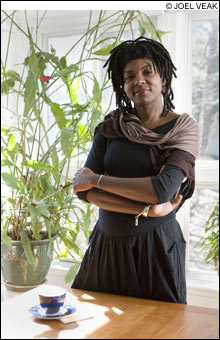
María Magdalena Campos-Pons: "There is a need for change in Cuba and I want to be part of that change.” |
Cuban artist María Magdalena Campos-Pons arrived at Boston’s Institute of Contemporary Art one December day in 1991. ICA video director Branka Bogdanov planned to record her, the usual Q&A, for a tape about an ICA group show she was part of. But the artist came to perform, in a white dress and with white stripes painted on her face and a red cross centered on her nose.
“The Six Difficulties,” she said in her native Spanish, with a serious stare. “Six things are difficult in this world/To be a woman/To be black/To be Cuban/To believe in love/To believe in people and the possibility that the world can be better.”
“I was absolutely overwhelmed with her energy, her enthusiasm, her beauty,” Bogdanov says. “That’s Magda. You can always expect something unexpected from her.”
Campos-Pons is one of Boston’s most prominent artists. She has shown at New York’s Museum of Modern Art, Minneapolis’s Walker Art Center, the Smithsonian, the Venice Biennale. This Sunday, the Indianapolis Museum of Art opens “Everything Is Separated by Water,” a mid-career retrospective of the 47-year-old’s paintings, sculptures, photos, and installations. Using her own story, her family’s history, her own body, she poetically explores themes of race and gender and what it means to live in exile.
In the spring of 1988, Campos-Pons tracked down Neil Leonard, then assistant director of MassArt’s computer center. She was studying there on an exchange program from Cuba, where she’d already finished her graduate work and taught. She was thin, with her hair in dreadlocks and her feet in bright green shoes. She carried a storyboard for her planned Super-8 film, and she was looking for a soundtrack. Someone recommended Leonard, who plays and composes jazz and electronic music and had visited Cuba twice to study its music.
The collaboration lead to weighty discussions of art and music. He took her to concerts by Cuban and gospel singers, and to hear him play his saxophone in jazz jam sessions at Wally’s Café. They walked the Arnold Arboretum, talking of her loved ones back in Cuba. Before long, she moved into his Jamaica Plain apartment.
At the end of the semester, she returned to Cuba. He visited for her birthday that July. She showed him her home town, La Vega, which is still dominated by the sugar plantation where her great-great-grandfather, a native of what is now Nigeria, worked as a slave. She grew up under Castro, performing patriotic revolutionary plays, studying oboe, and painting. The health care and the schooling were good; the long daily waits for bread, meat, and bananas were not. And her father never forgave Castro for the confiscation of a family house after the Revolution.
Leonard returned four more times before staying to live with her for a year. People whispered nasty things about the black woman and the blond-haired white man. But the couple navigated a thicket of international bureaucracy and won permission to marry in August 1989. It was a small, hastily arranged service in an international law office in a Havana hotel.
One day Campos-Pons came home shaken from had happened at her job with the Cuban visual-arts council. Officials wanted to shut down a gallery exhibit because they suspected that the paintings of Castro were vaguely, ambiguously critical. Campos-Pons convinced them that the exhibit wasn’t a threat and that censoring it would only turn the artists into martyrs. The next day the minister of the Interior called and told her to shut it down anyway. “Didn’t we agree to keep it open yesterday?” she said. “Yes. Shut it down,” he replied. “Is this an order?” she asked. “Yes,” he said. “I’m not in the military,” she snapped and hung up. The result: the show was closed and her boss was fired.
“I love Cuba,” Campos-Pons says. “I am very passionate about the possibilities there. There is a need for change in Cuba, and I want to be part of that change. But at that moment I knew it was a place where it would be very difficult to be there and keep yourself in a position where you are honest, where you are straight.”
She spent a year and a half in Canada on arts fellowships, with Leonard visiting from Boston on weekends, before the US allowed her to immigrate to Boston, at the end of 1991. The process left them exhausted and alienated, and angry.